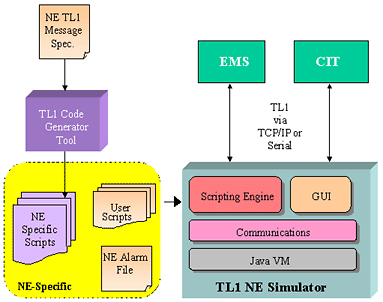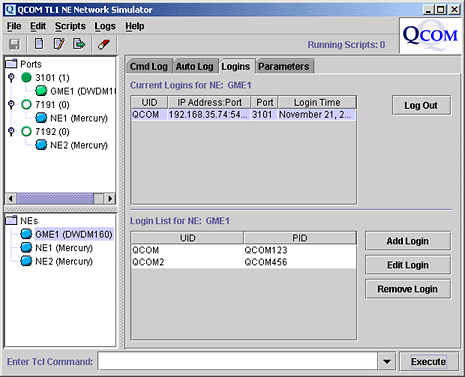TL1 NE Network Simulator
The main objective of a Networking Company is to shorten the development cycle as much as possible without sacrificing quality. During the development of a Management System, it is imperative to test the Management System with the actual Network Element. However, sometimes this is not feasible, as the equipment may be unavailable during the development cycle.QCOM presents its TL1 NE Network Simulator to make life easier for your development and Quality Assurance (QA) teams. Now you have the flexibility. You can begin testing your Management System without a real Network Element and you can test only those functions that are ready for testing. It's no doubt that, like other tools in QCOM Test Suite, using the TL1 NE Simulator can also offer significant time savings and cost benefits to your Company.
 |
| Fig. 1: TL1 NE Simulator Architecture Click to enlarge. |
As shown in Figure 1, the simulator's architecture consists of:
- Communications layer which handles TCP/IP and/or Serial communications to the Manager (EMS or CIT)
- Scripting Engine consisting of a built-in widely used Tool Command Language (Tcl) interpreter
- Graphical User Interface providing an easy to user interface for the user
Main Features
QCOM TL1 NE Simulator boasts a wide variety of features. The key ones are discussed below.
Simulates one or more NE's or GNE's
The Simulator is capable of simulating one or more Network Elements or Gateway Network Elements supporting TL1 over TCP/IP (or Serial). Since your network may be multi-vendor, the Simulator supports multiple NE types in a single instance.
Allows User Customization of Command Responses
The Simulator allows the user to customize and control all TL1 command responses. Responses can be generated using Tcl scripts or using text files which contain the exact TL1 response to send. This later method allows the use of captured TL1 output from the real NE.
Powerful Scripting Mode
Along with the user-friendliness of the Graphical Interface, QCOM TL1 NE Simulator provides the power of batch testing through its Tcl Scripting Mode. You can write scripts to provide the necessary NE behavior emulation or generate Alarm Storms.
Auto Generation of NE Specific Scripts
The TL1Sim Generator Tool reads your TL1 Message Set Specifications and generates Tcl procedures to automatically format and send valid TL1 responses.
Built-In Library of Tcl Procedures
The Simulator comes with a library of Tcl procedures, which can be used to format TL1 responses and autonomous messages.
REPT ALM / EVT Generation
The Simulator supports easy generation of REPT ALM, REPT ALM ENV, and REPT EVT autonomous messages using a user-provided alarm table containing a list of all possible Alarms that can be generated along with their default alarm parameters. It also maintains an Active Alarm and Condition List, which is updated each time a REPT ALM, REPT ALM ENV, and REPT EVT message is generated. Using this list, responses to RTRV-ALM, RTRV-ALM-ENV and RTRV-COND are automatically generated.
User-Friendly GUI Display
An extremely user-friendly Graphical Interface makes the TL1 NE Simulator very easy to work on.
 |
| Fig. 2: TL1 NE Network Simulator Click to enlarge. |
APPLICATIONS
- Test tool for developers in place of real equipment
- Simulate large networks of NEs
- Generate alarm storms
- Improves interoperability Testing & Quality Assurance
PLATFORMS
- Solaris
- HP UX
- Windows 98 / NT / 2000
- Linux
BENEFITS
Using the QCOM TL1 NE Simulator offers a variety of benefits.
Zero Wait Time
There is no wait time associated with QCOM TL1 NE Simulator. You can start testing from the day you are ready with the slightest functionality of your Management System.
Platform Independent
Developed in 100% Java, you can run the Simulator on practically any of the commercially available platforms. It has been tested on Solaris, HP UX, Linux and Windows 98 / NT / 2000.
One for Each
Your System Testers and Developers can each have their own copy of the QCOM TL1 NE Simulator and use it for the portions on which they are working. This saves them the pain of scheduling tests on real Hardware and having to change the test environment configuration each time one person takes over from the other.
FEATURE LIST
- Simulates multiple NE Types and multiple NE instances
- Simulates Gateway Network Elements (GNE's)
- Supports TCP/IP, TELNET, and Serial protocols
- Supports powerful scripting language (Tcl) for controlling simulator behavior and for running test scripts such as generating alarm storms
- Allows user control of all TL1 command responses
- Tracks user logins and validates ACT-USER login and password values
- Supports easy generation of REPT ALM, REPT ALM ENV, REPT EVT autonomous messages using a user-provided alarm table containing the list of all of the possible alarms that can be generated along with their default alarm parameters
- Maintains an active alarm and condition list which is updated each time a REPT ALM, REPT ALM ENV, and REPT EVT message is generated
- Automatic generation of the RTRV-ALM, RTRV-ALM-ENV responses using the active alarm list
- Provides a library of Tcl procedures which can be used to format the TL1 response and autonomous messages
- Supports File Transfer Protocol (FTP) to simulate NE software downloads and backups
- Supports sending E-mail (using SMTP) which can be used to notify the user of an event (or even trigger a pager)
- Supports Remote scripting, which means the user can execute Tcl scripts remotely from another machine
- Logging of all TL1 messages sent and received into a log file
- Simulates over 1000 NEs simultaneously
